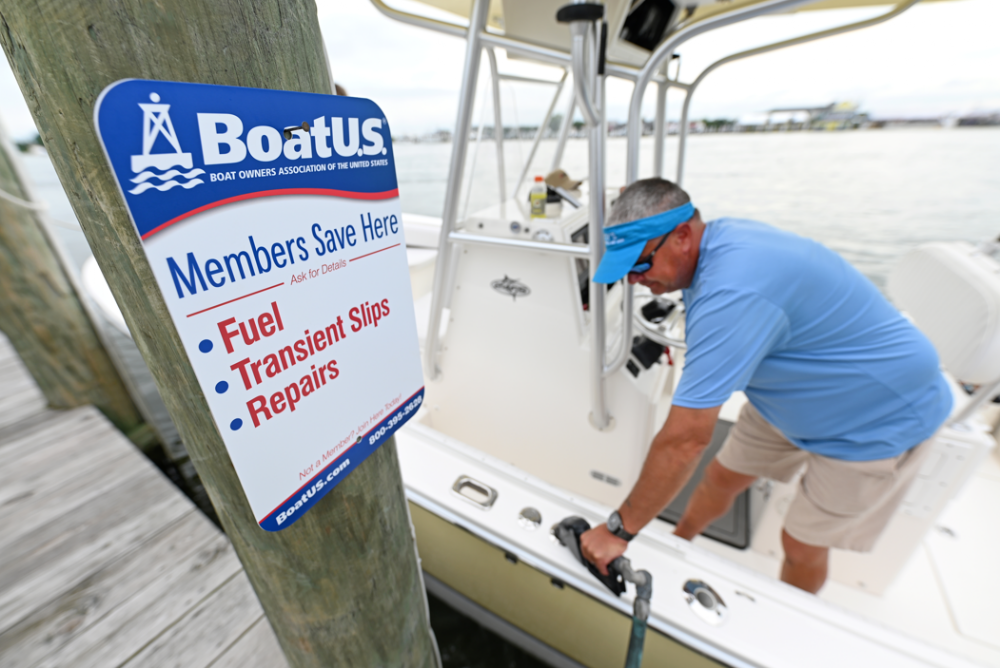21 Gas Saving Tips for Boaters
 BoatUS News BoatUS News
Gas prices are up. What can boaters do to prepare for a summer of boating? The 800,000-plus member Boat Owners Association of The United States (BoatUS) has 21 fuel-saving tips boaters can do to help save on fuel and still enjoy a fulfilling season on the water. While some of these techniques may sound obvious, there may be some you never considered.
Before Heading Out:
- Tune your engine now. A once a year for a tune-up and service will help it run more efficiently.
- Match the boat’s prop to the boat and activity. Propellers are most efficient when they’re matched to the kind of boat you have and what you use it for (e.g., towing water skiers, fishing). Ask the pros at a propeller shop for recommendations and experiment with different models. The right prop can potentially increase fuel efficiency by as much as 10%.
- Check your WOT. Take your boat out on a calm day and run wide-open throttle (WOT). The WOT rating is the RPM range the motor should achieve when running at wide open throttle. If it’s not able to reach WOT — or overruns it — you’ve got the wrong prop and you’re not getting the most bang for your fuel buck.
- Check for propeller damage throughout the season. A dinged or broken propeller will hurt your fuel economy, so regularly inspect yours and replace it if it’s damaged.
- Keep the prop clean. Barnacles and other growth can attach to the propeller, which will slow it down and impact fuel economy.
- Keep a slick hull. For boats that spend a lot time in the water, barnacles or stuck-on grass can create drag on the hull and make the engine work harder. Boats in warm places will probably need to be cleaned weekly, while those in colder waters may be able to go a month or two.
- Measure your fuel flow. Install a fuel-flow meter, which can show you in real time how many gallons per hour your engine is burning, and allow you to dial in the most efficient speed for your boat.
- Upgrade your motor — if you can. With the pandemic, engines have been hard to come by, but newer engines tend to be significantly more efficient than older models. The fuel savings alone might not be enough to justify an upgrade, but you’re likely also benefitting the environment. If your vessel is suitable, there are more options for electric and hybrid propulsion than ever before.
- Join BoatUS. Yes, this is a pitch, but it will save you gas money. Members receive exclusive marina fuel discounts at nearly 400 BoatUS Partner Network marinas across the United States that offer BoatUS members up to 10 cents off per gallon of fuel.
- Refuel smartly ashore. Most recreational boats in the U.S. are refueled at roadside gas stations, mini-marts and other retailers. It may be wise to enroll in the retailer’s customer loyalty or “cash back” program. Just read the fine print on how your discount is delivered. Your credit card company or grocery store may also offer percentage-based “cash back” program on fuel.
At The Dock
- Ditch extra stuff. Take stock of what’s onboard; additional weight means more drag. Clean out anything you won’t need, from extra anchors to old, unused lines and tools. Of course this does not include safety gear or necessary ground tackle.
- Lighten your tanks. Don’t run with a full freshwater or fuel tank unless you absolutely need it. Water weighs 8 pounds per gallon, and some boats have freshwater tanks that can hold 100 gallons, so emptying half can add up quickly. Gasoline weighs 6 pounds per gallon, so if you don’t need a full tank to safely return (you obviously don’t want to worry about getting stranded), lighten your load and bring less. A rule of thumb when planning for fuel use on any outing is you need to have one-third of your fuel to your destination, one-third back home, and one-third in reserve.
- Avoid excess idling. It’s a common misconception that engines need time to warm up. Modern engines are fuel injected, so when you start them, they’re ready to go in a minute or two.
- A note on safety: Self-refueling your boat while it’s in the slip at a marina with portable containers may be prohibited due to fire hazard or potential for a spill, and depending on the volume of fuel needed for a fill-up may be impractical. It’s also problematic as the risk of fire and explosion goes up when gas is transported in your vehicle. This type of refueling is better suited to small vessels with portable tanks that can be removed, filled at a gas station and returned to the boat. Regardless of how you refuel, follow all safety guidelines.
On The Water
- Rearrange your passengers. Evenly distributing the load aboard your boat is the simplest way to help you boat run most efficiently when the boat’s trimmed, which is roughly parallel to its at-rest waterline and not leaning too far to one side or the other.
- Get on plane. Most recreational boats run most efficiently when they’re on plane, so once you’re out of the no-wake zone, safely get on plane as soon as you can. If your boat has trim tabs, experiment with the up/down switch to find the sweet spot where your boat moves most efficiently and achieves the best trim.
- Watch your wake. One sign you’re blowing gas is the size of your wake. While sometimes you have no option, slowing down to no-wake speed saves fuel. It’s a matter of plowing a wall of water rather than efficiently slipping over or through it. Of course, wakesurfers will take umbrage to this tip. We get it.
- Try slowing down. Yeah, that’s a hard one for a lot of us, but in addition to stretching a tank of gas, it’s safer. You’ll see more things and have more time to react in the water, such as other boats or approaching traffic.
- Reduce wind drag. A canvas or bimini top is great for protection from the sun, but you can improve fuel efficiency while underway by taking it down if you can. Just be sure to bring — and apply — sunblock.
- Navigate smartly. The ultimate trick to saving fuel, of course, is running your engine less. Travel to closer destinations or drop anchor somewhere nearer to home to enjoy your fun afternoon on the water. If possible, take the shorter route and route trips in synch with current and tide, and try to avoid a lot of banging into head seas.
- Share your angling outings by “buddy boating.” Head out this weekend by inviting the guy in the slip next to you, and then rotate on the next weekend’s angling outing. This fuel-saving technique is especially popular with anglers who fish canyons far offshore. Of course, this also improves your social aspects of fishing life as well.
Photos
Member Comments…
|
|

 Login
Login




